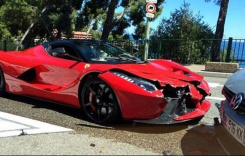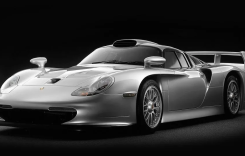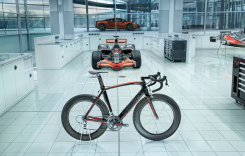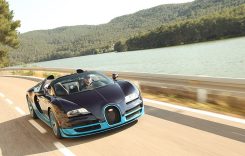Triumph virtually defines the production café racer class with its Thruxton motorcycle. Although it’s been a while since it received an overhaul—with its timeless good looks and the stone axe reliability of its Parallel Twin engine it’s really hard to find fault with the British bike.

Seated in the controls the Triumph fits the rider like a worn-in leather glove. The clip-ons are positioned low and the footpegs are mounted far back on the frame which may be a stretch for some riders, but worked well for us. It’s for sure less accommodating as compared to the Moto Guzzi for riding around town but you can’t help but feel like you’re more a part of the machine when seated inside the Thruxton.
It’s this relationship that makes it so enjoyable to ride on an open road. The Thruxton carves through corners in a sportier manner than the V7 Stone while the suspension damping is plush and does a fine job of soaking up imperfections on rough and bumpy road.
Around town the low clip-ons and the overly rearward position of the footpegs make it more cumbersome to maneuver, especially at parking lot speeds. It’s here that you feel the Triumph’s extra weight too. Despite carrying less fuel (a 4.2-gallon tank versus the MG’s 5.8) the Thruxton weighs 67 pounds more, tipping the scales at 506. Compounding that is the marginally 0.7-inch taller seat. It’s these factors that make the Triumph a little more challenging to ride at slow speeds.
(Top) The Triumph Thruxton performs best on your favorite curvy road. (Bottom) The sound generated by the Triumph’s Parallel Twin engine is incredible.
“When you’re on the highway or railing around corners the Triumph works really well,” shares Garcia. “But when you’re tip-toeing in a parking lot or riding around town or through a series of traffic lights the Triumph just feels kind of awkward—especially with how far back the footpegs are.”
Thumb the starter and the Triumph’s Parallel Twin fires to life with zero hesitation whether the engine is hot or cold. It also requires virtually no idling or warm-up time before it can be ridden away cleanly. Sound-wise it’s hard not to be impressed with the engine whine and exhaust note emitted from its twin chrome pipes. It’s a far more pleasing sound which rewards the Triumph rider more so than the monotone drone of the V7’s Twin. The engine also vibrates much less, which in turn, allows for a clear picture from the rearview mirrors.
Sound testing demonstrated that the Triumph posted identical noise-level reading at idle compared to the Moto Guzzi (78 dB). Get the motor spinning at 4000 rpm (half of maximum engine speed) however and we measured 96 dB—one point louder than the Moto Guzzi, making it more susceptible to attention from cars (good) and neighbors (bad).
Twist the throttle and the Triumph doesn’t deliver as much acceleration out of the hole as compared to ‘Guzzi’s low-end torque monster of a motor. But get the tachometer needle pointing north of 5000 revs and the Thruxton gets with the program and actually delivers both more torque and horsepower up through its 8000 rpm redline. Peak torque arrives at 6500 rpm with 47.77 ft-lb available—just over seven more than the Guzzi. But the big difference in power is measured in horsepower with the Triumph’s mill generating almost 21 horsepower more than the Italian machine. This gives the Thruxton a more versatile powerband that can be appreciated by all riders.
“It’s pretty obvious that the Triumph has a better engine,” says Garcia. “Not only is it smoother, but it delivers a broader spread of power. It also vibrates a lot less and sounds fantastic.”
Despite its extra weight the Triumph got rolling to 60 mph from a stop in 4.47 seconds compared to the V7’s time of 5.31 seconds. It also performed better through the quarter mile with a time of 13.6 seconds at 100 mph. That’s 1.28-seconds quicker than the Guzzi at a 13-mph higher trap speed, too.
The Triumph’s drivetrain also proved to work better. While the clutch felt more or less the same as the unit inside the Moto Guzzi the five-speed gearbox was more precise making mis-shifts far less frequent. It also offered a shorter shift lever throw between each gear and made it simple to find both first gear and neutral.
(Top) Moto Guzzi Stone V7 vs. Triumph Thruxton Dyno Chart(Bottom) The Triumph Thruxton has an aggressive riding position which works great on curvy roads but is awkward feeling on city streets.
Although both motorcycles make use of a simple but effective single hydraulic disc brake front and rear the British bike’s set-up proved to feel and perform a little better. During a simulated panic stop from 60 mph the heavier Triumph was able to stop in four fewer feet than the Moto Guzzi (148 vs. 152). The brakes also felt like they worked better too offering superior feel which made them easier to use near the limit of traction.
Since it has slightly more engine capacity we weren’t surprised that the Triumph offered lower fuel mileage numbers. Throughout mixed freeway, urban and canyon riding we averaged 41.6 mpg compared to the ‘Guzzi’s 44.4 mpg average. This gives the Thruxton a range of around 174 miles which falls a bit short of the V7’s estimated 257-mile range.
In spite of its small short comings, a list that includes the demanding riding position and the few extra pounds it carries, the Triumph is a great motorcycle. It offers just enough performance to keep a big smile underneath your helmet plus the engine sounds so delightful that you almost can’t help yourself from riding it hard. It also is more refined with fewer hiccups and quirks that can take a little bit of the fun away from riding. It’s these reasons why you should buy English when it comes time to ride your own piece of rolling history.









